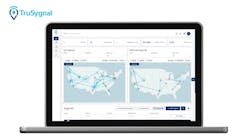From an outside point of view, the relationship between shippers and commercial motor carriers seems simple. Shippers want a partner that can meet their needs by picking up and delivering freight on time and at a fair price, while fleets want to work within their lanes and freight network, and with a partner that pays on time.
Historically, however, there has been a battle between shippers and carriers, Dan Clark, Trimble VP of product innovation and strategy and founder of Kuebix TMS software, pointed out. Shippers have been notorious for detaining carriers for long periods of time, while carriers that might have been too focused on wanting to haul as much freight as possible were not realistic about working with partners that fit in their direct networks.
“Volatility in the market really brings visibility to a lot of the issues that happen between shippers and carriers,” Clark said. “The one word is partnerships. Looking at it from both lenses, at the end of the day both parties need to be able to do business better together.”
In today’s volatile market, carriers have the upper hand because of incredibly tight capacity and a strong demand to move freight quickly to fulfill burgeoning consumer needs. Technology can help remove friction from the shipper-carrier equation, allowing for increased transparency, visibility between each party, and more efficient onboarding processes.
For Ben Wiesen, president of Carrier Logistics Inc. (CLI), a technology vendor to asset-based less-than-truckload carriers, the public conversation over the last 15 years or so has always been about how technology can be used to help shippers and carriers collaborate and make the supply chain more efficient for everyone. But the real discussion is often about reducing spend from the shipper’s perspective and becoming more profitable from the carrier perspective, he noted.
“Now, all of a sudden for the last 18 months, we’re in this situation where the public conversation has also become the boardroom conversation,” Wiesen explained. “The shippers have a higher appreciation for the service that the transportation providers give to them, and the carriers recognize that if they’re going to be profitable and sustain the profits they are making short term, they really do need to have technology working for them in collaboration with their customers.”
Compounded by the tightening capacity crunch and the effects of the pandemic, the top priorities for both shippers and carriers have pivoted. Rather than solely focusing on profits, both parties are more concerned than ever about fulfilling orders and removing as much friction as possible when it comes to moving freight from point A to point B.
Meeting expectations
Since the start of the pandemic, there has been an even greater need for both shippers and carriers to be very clear about their expectations of one another.
When a shipper puts out a request for proposal (RFP) providing their operational requirements, LeAnne Coulter, VP of freight management at Penske Logistics, said it’s important they also detail exactly what they are looking for before securing capacity. That transparency gives carriers a more accurate understanding of the shipper’s expectations and any potential constraints ahead of time.
Carriers should also make it a point to ask questions right off the bat about items that are drivers for their business. For instance, does the shipper do drop and hook? Does the shipper offer live load and live unload? What are turn times in a live-live loading and unloading situation? Does the shipper allow for driver parking at their facility? Is the facility accessible 24 hours a day? Are appointments required?
“All of these things have an impact on not only the function of operating for the carrier but also their pricing,” Coulter explained. “It’s also really important once an award is made to have a very clear onboarding call and talk about the award.”
During that onboarding call, shippers and carriers should both specify how their lanes function. Shippers should also thoroughly explain how their facility operates so drivers know what to expect when they arrive. That means informing carriers about in-gate and out-gate procedures at the facility, as well as any necessary data points to ensure a smooth transaction.
“So, all the details come out before that first shipment goes, otherwise that first shipment is likely to be at risk, with different parties likely disappointed in the results of those shipments,” Coulter advised. “The most successful engagements really are going to include that relationship, sharing information, and providing for that two-way dialogue so everybody understands exactly what is expected. But it is the shipper’s facilities, it is their property, and it is their product, so it is certainly incumbent upon them to communicate their expectations.”
For carriers looking to better meet shippers’ expectations, communication is critical and should be ongoing from the start. Coulter stressed the importance of carriers being upfront with shippers when a problem occurs, as well as an estimated timeframe for when that issue will be resolved. One of the biggest grievances that shippers have with fleets is late freight pickups and deliveries.
“If a driver is stuck in traffic, even if there is a visibility software or application being used, that communication to that receiving location or to the next stop is important,” she explained. “It builds that relationship, it builds credibility, and it makes sure that you have that opportunity as a carrier to let your customer really know what’s going on.”
CLI’s Wiesen pointed out that for years, shippers have claimed that more than anything they want visibility. Today, with all the constraints in the supply chain, visibility is an essential service a truck driver and/or carrier can provide amid the disruption and uncertainty.
Even an hour of additional visibility into a possible disruption gives a shipper time to work around that problem, Wiesen added. And more than ever, shippers today are looking for real-time updates on every shipment that is scheduled and from the time the truck is on order to when the freight is delivered.
“You can’t fix what you don’t know is broken, and shippers are desperate to know what’s broken,” Wiesen explained. “They know something is going to be broken; it’s inevitable when you’re in this tight a market. But if they know where the problems are in real time, they can proactively solve some of those problems. If they don’t have visibility, they’re in the dark.”
The good news for both parties is that today’s transactions have evolved and are much more refined.
“Gone are the old days of 'we’ll send a truck, it’ll get there, it’ll sit around until it’s used, then it will go to where it needs to go,”' Wiesen noted. “It’s now being planned, optimized, reoptimized, and transportation has become a well-oiled machine. The number-one most important thing a shipper can do to collaborate effectively with their transportation provider is to deliver advanced visibility into the transportation requirements and not change those requirements unnecessarily.”
Last-minute changes from the shipper can hurt carriers that are trying to optimize and utilize their limited capacity. Wiesen advised that the longer out a shipper can provide a forecast for carriers, the better—even if it’s just a few days in advance.
“Carriers no longer want to be paid for what they’re doing,” Wiesen said, meaning they would rather eliminate detention time altogether because delays make capacity unavailable for the next shipment. “They want to do what they are supposed to do, which is pick up, move, and deliver freight. Every time they are ‘getting paid for what they did,’ it’s another customer whose needs aren’t being satisfied. Carriers are feeling huge pressure to move the freight. They don’t want the delays, even if they are being paid for it, because it leaves another customer screaming. So, the most important collaboration that the shippers and the carriers can do is establish that short-term forecast and make sure it’s adhered to.”
A partner of choice
The industry has been dealing with a driver shortage for some time now. In the year before the pandemic, the American Trucking Associations (ATA) reported that the industry was short some 61,000 drivers. Today, ATA estimates a shortage of 160,000 professional drivers by 2028.
But it’s not just a truck driver shortage. The entire labor market is feeling a capacity squeeze these days.
“All employment—human capital—remains an intense challenge for carriers,” Wiesen pointed out. “They can’t get enough drivers behind the wheel. They can’t get enough forklift drivers moving freight across the dock. They can’t get enough customer service reps.”
In addition, carriers are also dealing with component shortages and challenges procuring the equipment needed to fulfill demand.
Another constraint as the entire supply chain shifts to fulfill last-mile delivery needs is real estate has become more difficult to find, and it’s more expensive.
“As the freight sort of backs up and gets stuck in certain locations in the supply chain, you need the physical real estate to warehouse freight and to release freight at the right time,” Wiesen added. “Real estate is so hard for the carriers to come by right now.”
Currently, all players throughout the supply chain are trying their best to be as creative as possible to eliminate delays and friction. That’s when becoming a shipper or carrier of choice comes into play.
“We always talk about shipper of choice (SOC), and it’s not only about the communication and the transparency, but it is also about being very cognizant of the interaction with the driver on the property and providing space for drivers,” Penske’s Coulter said.
Being cognizant of the driver experience could mean having parking available for drivers to potentially take their mandated rest period rather than having drivers park unsafely along the side of a highway. Shippers should also ensure that their in-gate and out-gate processes, and the actual delivery of the product are clear. Drivers should also be able to maneuver their trucks up to the door or around the yard, Coulter noted.
“A tightly laid out and very cohesive yard is important,” she said. “Try not to bury a carrier’s trailers four deep, so drivers can’t get their equipment out—that doesn’t allow for any type of efficiency to happen.”
Michael Zimmerman, a partner with Kearney and co-author of the Council of Supply Chain Management Professional’s (CSCMP) and Penske’s annual "State of Logistics Report," said shippers should take a two-pronged approach when considering their SOC program. They should conduct a self-assessment and carrier survey (with anonymity as an option), and they should read reviews that truckers post about their sites.
Using these inputs, Zimmerman said certain segments of shipper-to-carrier interaction should be assessed in an SOC program: carrier relationship management, capacity planning and commitment, tender execution/track trace, and post shipment relationship such as payment and claims resolution.
“The SOC program should assess strengths and weaknesses of the shipper at each site and globally, and then put an improvement program in place, in consultation with the carriers so they see the critical self-assessment and see that efforts are being made at improvement,” Zimmerman told FleetOwner. “Easier things to do are courtesy at check-in by the guard shack, a clean waiting room and bathrooms, working vending machines and a TV, and more efficient paperwork management—paperless is better. Harder things might include adding a scale, building showers, or expanding dock or yard capacity.”
How technology can help
Transportation management software (TMS) systems can help shippers plan, execute, and track their captive and common carrier fleets. According to Zimmerman, most shippers today have web-based interfaces for carriers and customers to monitor load planning, execution, and load status. Some TMS systems have begun automating the anticipation of delays and will notify shippers and their customers of impending delays and alternative actions.
The bottom line, Zimmerman explained, is that there’s an overabundance of available technologies and IT services to create custom visualization, analytics, optical character recognition, and artificial intelligence/machine learning capabilities to maximize the ability of shippers, carriers, and customers to understand and share what is going on.
“To collaborate more closely with one another, shippers and carriers must select the interfaces that best strike the balance between cost, speed of implementation, ease of use (for shippers, carriers, drivers, customers—as each has different needs), and completeness of communication content—ideally planning, execution, track and trace and payment/issues resolution,” Zimmerman said.
Trimble’s Clark added that technology can also help streamline proof of delivery requirements, which shippers typically rely on before paying a carrier. Working with the technology, both shippers and carriers have real-time visibility and information to better negotiate the terms of their partnership.
“This way both the shipper and the carrier are working within the agreement they have with one another,” Clark said. “The technology holds both sides accountable to make sure that they meet the requirements of each other.”
Clark added that all too often, shippers require a lot from carriers but fail to communicate those expectations clearly. The problem there is that carriers are then rated based on those requirements.
“What ends up happening is people fail to follow the compliance and they fail to follow the routing guides, and then the relationship between the shipper and the carrier goes south,” he said. “In reality, it’s because there was no collaboration or real-time understanding of what was happening in the process.”
Technology can also help when it comes to the two parties agreeing on basic standard operating procedures (SOPs).
In the old days, Clark explained that the SOPs both parties agreed to might have been put in place, but without technology and proven data points, a he-said, she-said argument ensued. Carriers might have been blamed for late deliveries, when, in reality, the shipper never had the freight available.
Today, however, shippers have the ability to automate the process for carriers by making freight shipments easy to award. Delivery receipts can be integrated directly, and the whole process of bill entry is eliminated for the carrier, Clark noted. Shippers can also use technology to help carriers better understand what their needs are within certain lanes and networks when they first post a load.
Technology and data insights have also helped carriers determine productive versus unproductive miles, allowing them to match freight runs that best fit in their networks.
“Whether it’s done through technology or a telephone call, there is a relationship piece of this business that I still think is important, especially between shippers and carriers,” Clark stressed. “I think a lot of times technology does so many great things for keeping people accountable for what they agreed to, but at the end of the day, it’s just good to do business with people you want to do business with. I think we forget the importance of that relationship.”






